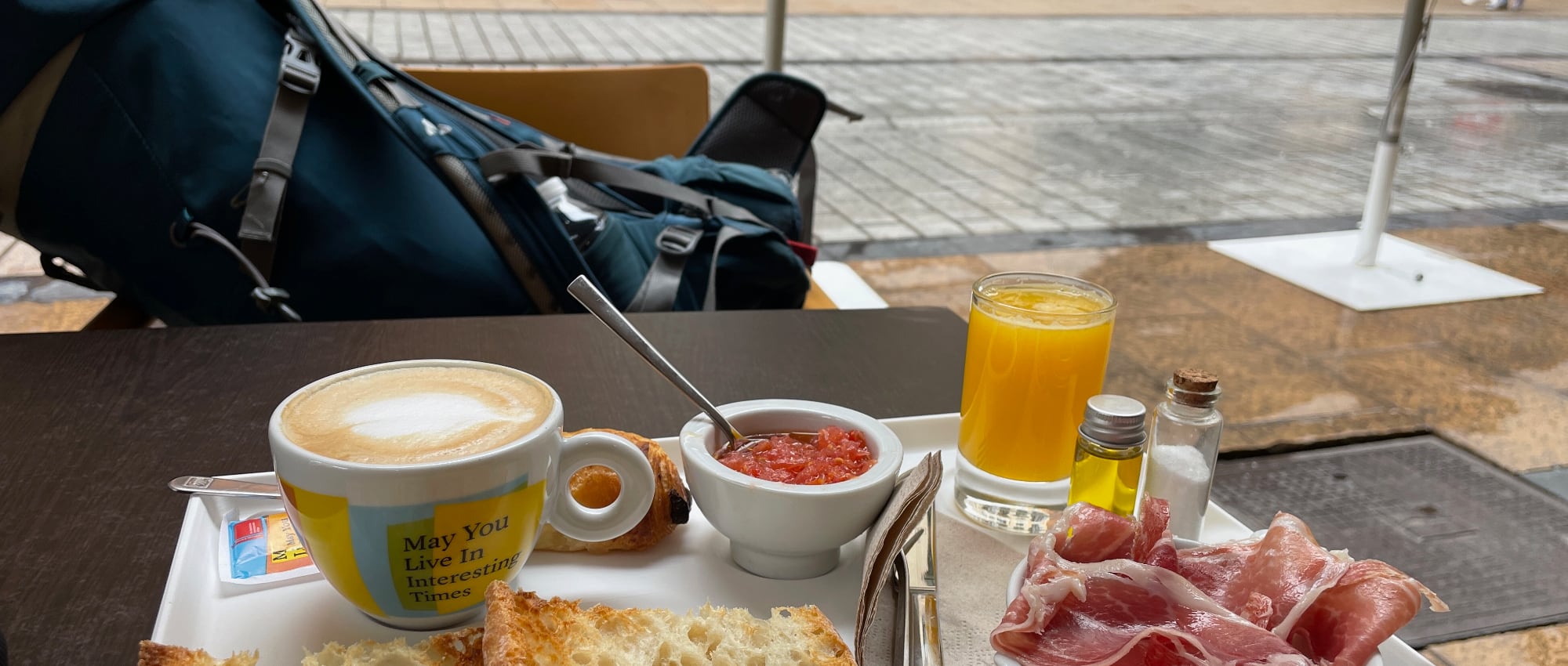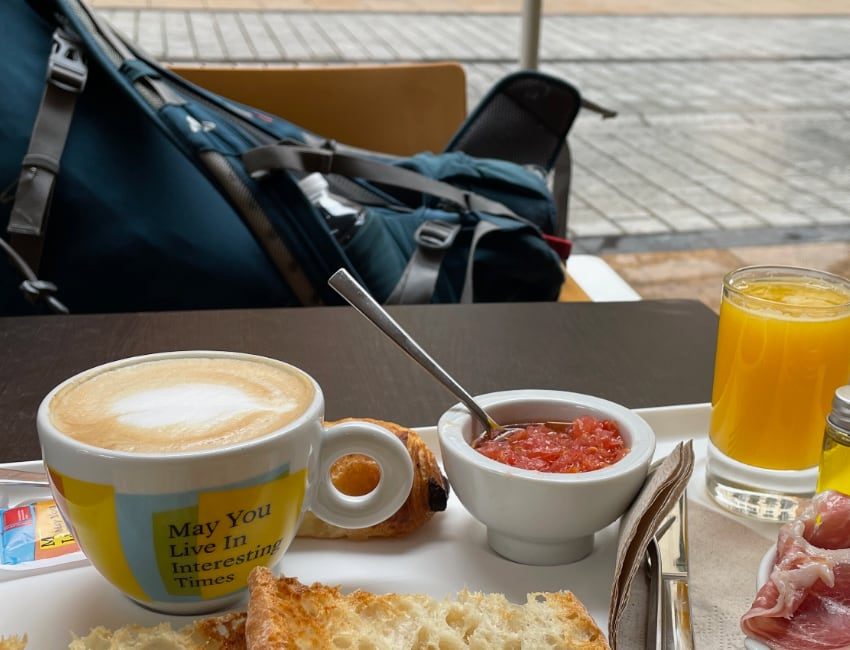If you walk that many miles a day, you need to eat properly – but pilgrim menus aren’t always the best choice.
Let's start at the beginning: Breakfast
Even those who are lazy about breakfast in everyday life, quickly learn on the Way of St. James that an empty stomach is not a good basis for long marches (exceptions of course), but have just as passionate “breakfasters" often the problem that a solid breakfast is not so easy to find.
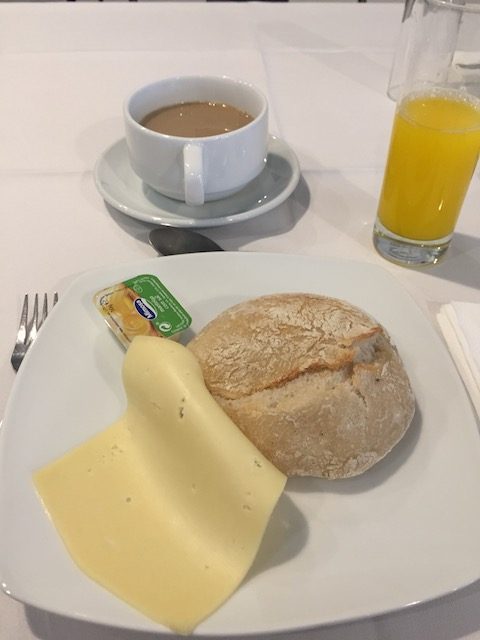
The breakfasts offered in hostels, guesthouses and hotels are often not very nutritious.
Depending on the price range, you are often fobbed off with a few cornflakes and a white flour roll with jam, if you are offered cheese and ham, the joy is already great.
Even in more expensive accommodations for pilgrims, the breakfast is often poor and not comparable to what is served in Western and Northern Europe.
One might think that it is a good idea to have breakfast in town.
This is possible in larger cities, but a normal bar offers you only coffee and croissant – your dream of scrambled eggs, wholemeal rolls or yogurt with fruit will stay a dream.
At noon: pilgrim menu or menu of the day?
They used to be more common even in the normal gastronomy along the way, but in recent years they have disappeared more and more from the scene: Pilgrim menus.
But that doesn’t matter, because most of the time they weren’t of good quality anyway and also in terms of price they weren’t a real gain compared to the “Menu do dia" or “Menu del dia", the menu of the day, which is offered in Portugal and Spain at lunch time in bars and restaurants of different price levels.
I had the cheapest menu in Portugal for 3.8€, but usually 7-8€ is due. This includes a vegetable soup, a main course (usually there are several to choose from), a drink and often a coffee.
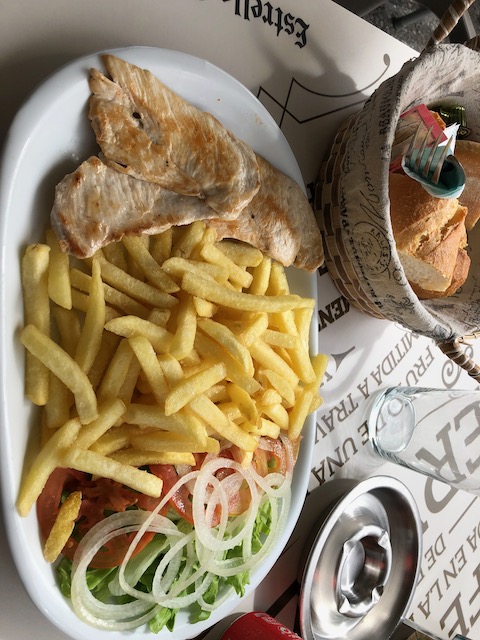
Whether it is wise to eat opulently at lunchtime when there are still so many kilometers ahead of you is a question of type and sometimes also the shape of the day.
A salad plate is not easy to get in the usual bars along the way and so a sandwich is often a good alternative.
Dinner-Time!
Stage done, body and clothes cleaned and now you deserve something decent to eat!
In hostels and some hostels there is the possibility to provide yourself. Go to the supermarket and cook what you feel like – if you feel like cooking.
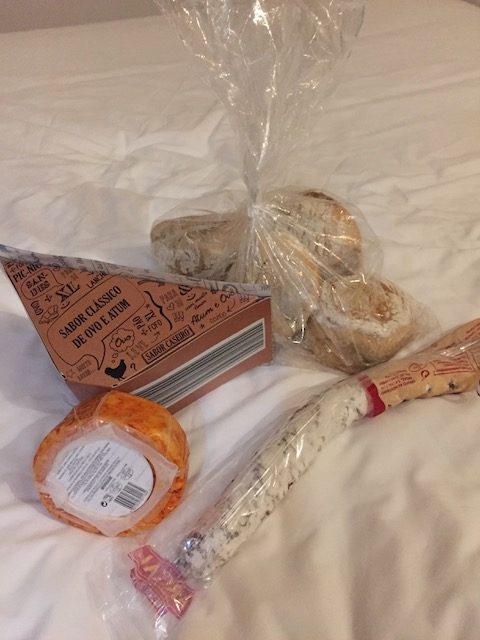
Otherwise you have to go to the next bar. Depending on the size of the town, the choice is more or less manageable.
Or you can go to the supermarket – if available – and get bread, cheese, ready-made salad or anything else that can be prepared without a kitchen.
To bring in a little variety, it is highly recommended to look in cities whether there is international cuisine as an alternative to the classic Portuguese or Galician food, so that you do not have that too quickly over if you stay in a place where there is only that.
Portugal and Galicia: Typical Cuisine
Portuguese cuisine is rather simple, there is no tendency to use intense spices or exotic combinations.
Of course, fish plays a big role, but it is also surprisingly meat-heavy, especially pork is very common.
In a classic Portuguese bar that also has a kitchen, you will often find the following on the menu:
Snacks
Tosta Mista – a toast with cheese and ham
Sopa – whether it’s Sopa de Verdure, the vegetable soup, or Caldo Verde (there’s a slice of sausage floating between the cabbage), soup is an essential part of the Portuguese diet and belongs before almost every meal. Cost: 2-3€
Cachorro – Hot Dog
Main courses
Bacalhau in any form, the stockfish is indispensable in Portugal. Classic is for example Bacalhau a Bras with potatoes and egg.
Prego – “steak". So rather a thin piece of too long roasted beef, than what one defines as steak. You can have it “no prato", plain, or “em pão", in bread.
Alheira – a Portuguese sausage.
Omelete – The omelette is often offered in “semplice" or “mista", where mista again means that it has cheese and ham in it.
Rojoes – a dish made with pork and potatoes.
Dessert
Pastel del Nata – tartlet made of puff pastry filled with a cream, must be tried!
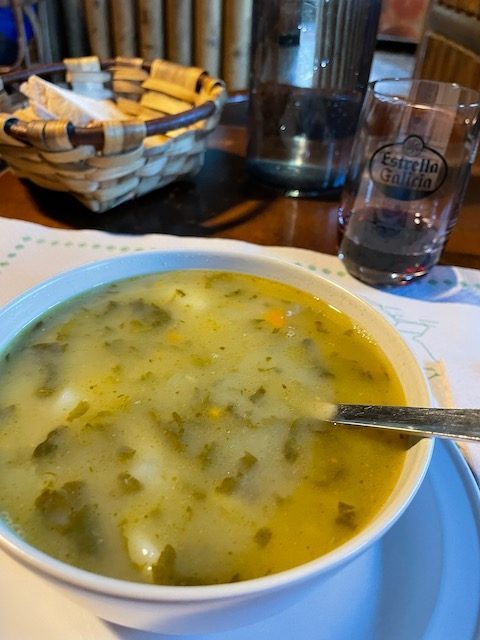
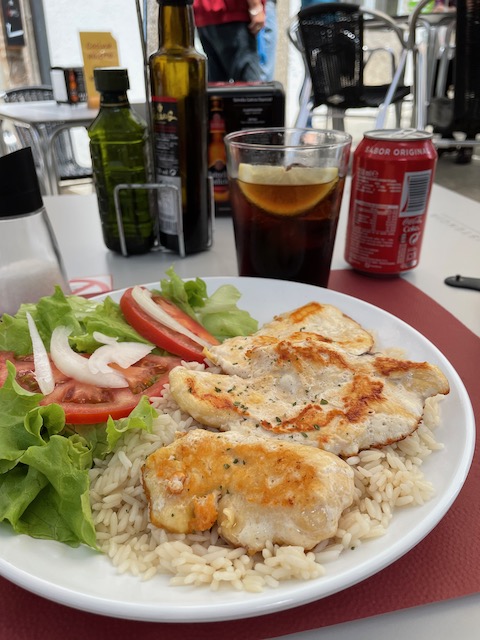
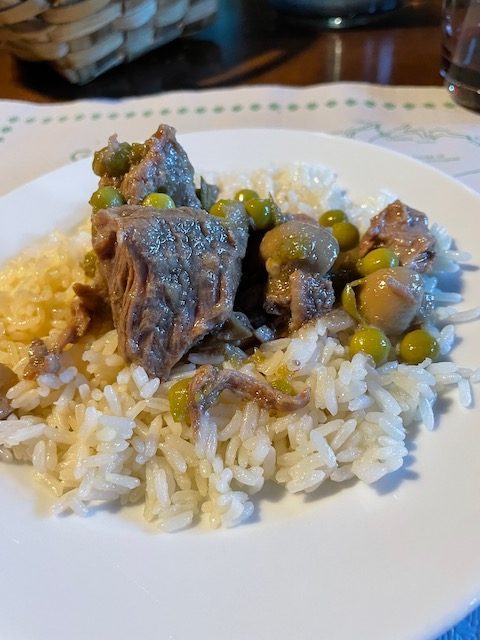

Galician Cuisine
There is a saying in Spain “there are no cows in Galicia", which is used when someone says something very obviously wrong.
Not surprisingly, Galician cuisine is actually very beef-based.
Of course, you will also find tapas in Galicia, although not as widley spreaded as in other regions, so here you can also enjoy various small portions of fish and seafood, tortilla, chorizo, etc.
In Padron it is of course obligatory to eat Pimentos de Padron, grilled mini peppers.
A great breakfast option is Pan con Tomate, which is as simple as it sounds: toasted bread with more or less strained tomatoes and some olive oil on top.
(Living in Portugal, I must admit I’m a bit more familiar with Portuguese cuisine than Galician.)
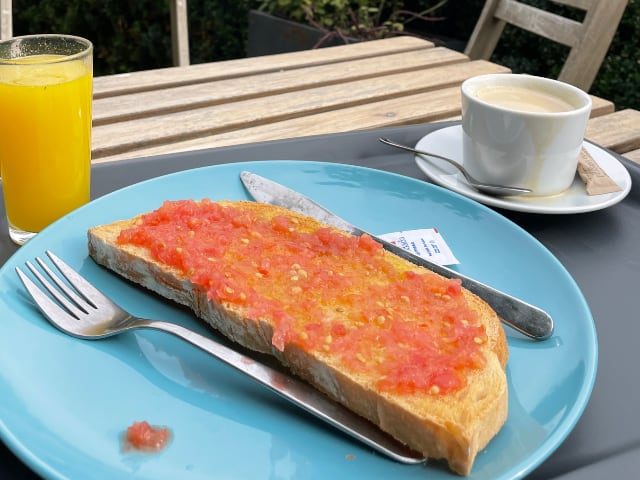
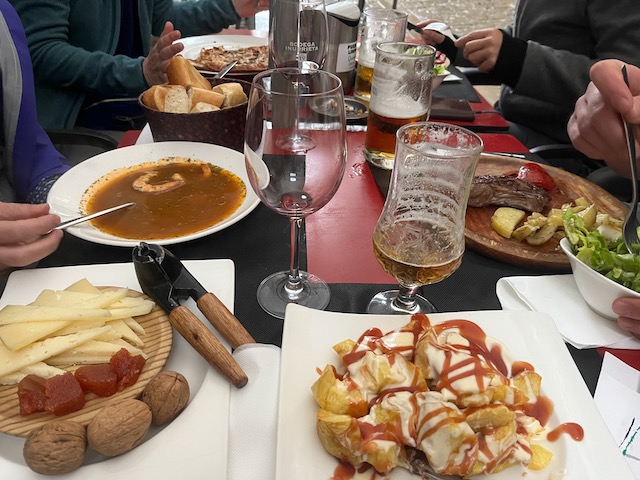
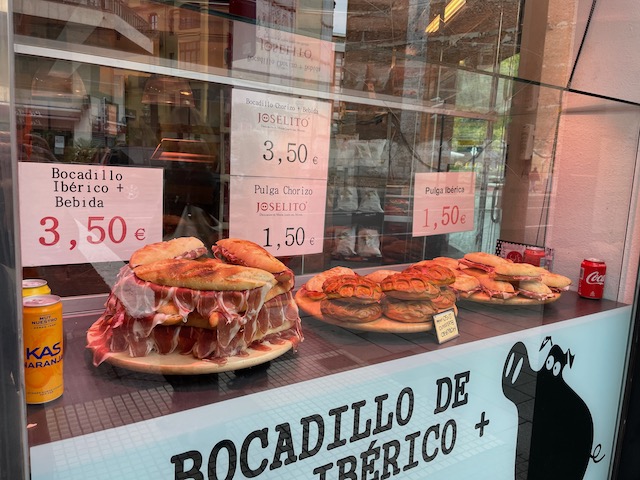
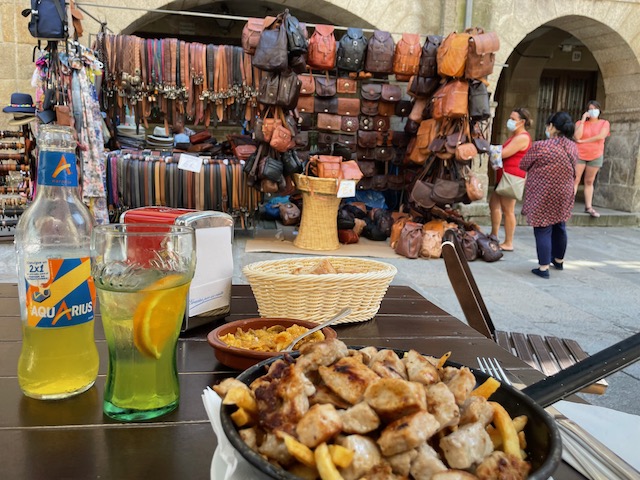
As a vegetarian on the Portuguese Camino
I say it directly: not so easy.
Of course, in cities like Porto you have the choice between umpteen vegetarian and vegan restaurants, but if you stay in the smaller towns and depend on the only bar in town, it can quickly become monotonous.
If you look at the vegetarian dishes, there is often either nothing at all, or always the same:
Omelet or vegetable lasagna.
Most vegetarians on the camino have also the cheese sandwiches, often the only option at lunch, quickly over and are then little motivated to equip themselves in the small store around the corner with bread and cheese for dinner.
And so it often remains only to ask and hope that the chef come up with something better than “french fries".
So for vegetarians is especially recommended: eat well at the larger towns and in the hamlets survive with omelettes, vegetable lasagna or french fries.
Do you always lose weight when you walk the Camino de Santiago?
You would think so, but: no.
Yes, most people actually lose something between “a little" and “several kilos" of weight, even if they are only on the way for two weeks.
But that’s not true for everyone, for some it just doesn’t work, whether it’s because of the wine in the evening or whether the metabolism simply works differently there, has not yet been scientifically researched 🙂
